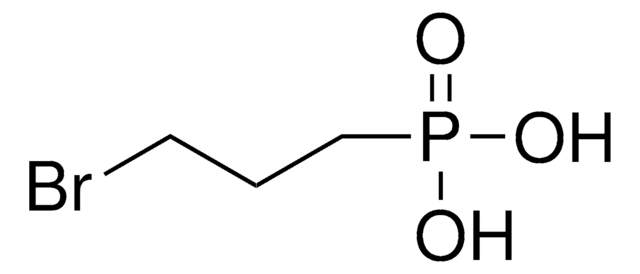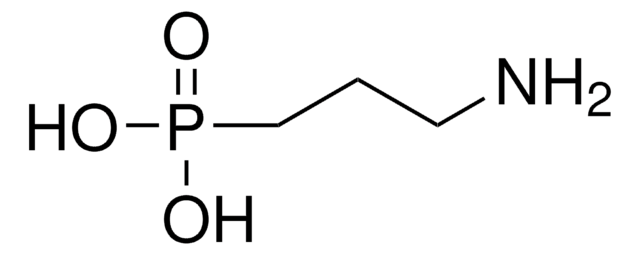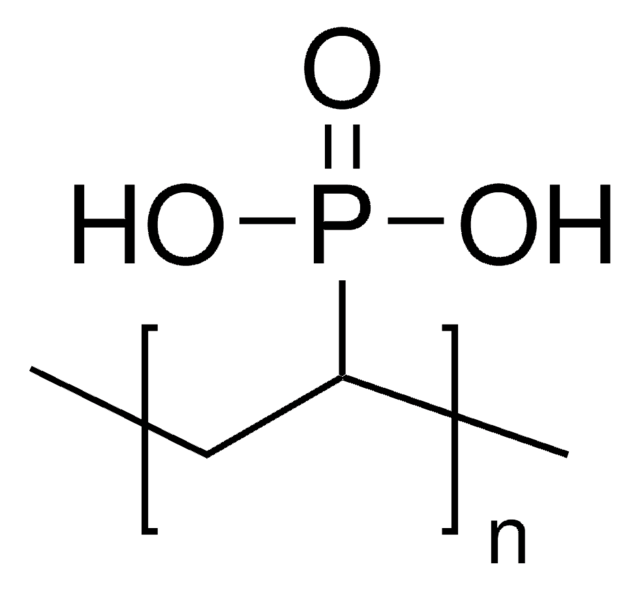745855
12-Mercaptododecylphosphonic acid
95%
Synonyme(s) :
P-(12-Mercaptododecyl)phosphonic acid
Se connecterpour consulter vos tarifs contractuels et ceux de votre entreprise/organisme
About This Item
Formule empirique (notation de Hill) :
C12H27O3PS
Numéro CAS:
Poids moléculaire :
282.38
Numéro MDL:
Code UNSPSC :
12352103
ID de substance PubChem :
Nomenclature NACRES :
NA.23
Produits recommandés
Niveau de qualité
Essai
95%
Forme
powder
Pf
92-96 °C
Température de stockage
2-8°C
Chaîne SMILES
OP(O)(CCCCCCCCCCCCS)=O
InChI
1S/C12H27O3PS/c13-16(14,15)11-9-7-5-3-1-2-4-6-8-10-12-17/h17H,1-12H2,(H2,13,14,15)
Clé InChI
PVIUMTORLYKRJT-UHFFFAOYSA-N
Catégories apparentées
Description générale
12-Mercaptododecylphosphonic acid (MDPA) is an organophosphonic acid that forms a self-assembled monolayer (SAM). The phosphonic groups tend to react with the metal surfaces that allow the formation of metal-oxygen-phosphonate (M-O-P) bonds that facilitate the surface with mechanical and chemical stability.
Application
MDPA based SAM can be coated on TiO2 for potential applications in the extraction of heavy metals. It can also be used in surface modification of a graphene oxide (GO) based active material for the fabrication of a organic field effect transistor (OFET).
Organophosphonic acid self-assembled monolayers (SAMs) for nanoelectronics; solid-state lighting; energy generation and nanocomposites. A mercaptoalkylphosphonate monolayer used to bind gold nanoparticles.
Mention d'avertissement
Warning
Mentions de danger
Conseils de prudence
Classification des risques
Eye Irrit. 2 - Skin Irrit. 2 - STOT SE 3
Organes cibles
Respiratory system
Code de la classe de stockage
11 - Combustible Solids
Classe de danger pour l'eau (WGK)
WGK 3
Faites votre choix parmi les versions les plus récentes :
Déjà en possession de ce produit ?
Retrouvez la documentation relative aux produits que vous avez récemment achetés dans la Bibliothèque de documents.
Les clients ont également consulté
Peter J O'Brien et al.
Nature materials, 12(2), 118-122 (2012-11-20)
Manipulating interfacial thermal transport is important for many technologies including nanoelectronics, solid-state lighting, energy generation and nanocomposites. Here, we demonstrate the use of a strongly bonding organic nanomolecular monolayer (NML) at model metal/dielectric interfaces to obtain up to a fourfold
Self-Assembled Monolayers of 12-Mercaptododecylphosphonic Acid on Titania Particles; Application to the Extraction of Heavy Metals
Antherieu S, et al.
MRS Online Proceedings Library, 847(1), 141-149 (2004)
Driving forces for the self-assembly of graphene oxide on organic monolayers
Kirschner J, et al.
Nanoscale, 6(19), 11344-11350 (2014)
Phosphonate monolayers functionalized by silver thiolate species as antibacterial nanocoatings on titanium and stainless steel
Amalric J, et al.
Journal of Materials Chemistry, 19(1), 141-149 (2009)
Randall M Stoltenberg et al.
Langmuir : the ACS journal of surfaces and colloids, 27(1), 445-451 (2010-12-08)
Developing orthogonal surface chemistry techniques that perform at the nanoscale is key to achieving precise control over molecular patterning on surfaces. We report the formation and selective functionalization of alumina nanoparticle arrays generated from block copolymer templates. This new material
Global Trade Item Number
| Référence | GTIN |
|---|---|
| 745855-250MG | 4061832882512 |
| 745855-1G | 4061826208267 |
Notre équipe de scientifiques dispose d'une expérience dans tous les secteurs de la recherche, notamment en sciences de la vie, science des matériaux, synthèse chimique, chromatographie, analyse et dans de nombreux autres domaines..
Contacter notre Service technique










